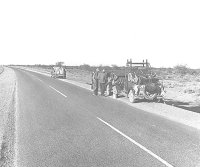
They called them Okies and Arkies. Soon many of these refugees from the "Dust Bowl" were called names a whole lot worse then that when Arizona and California became inundated by people desperate for work, any kind of work. Almost every American and many people around the world caught a glimpse of the Okies and the misery of these people through the book and movie "The Grapes Of Wrath". Much more truth then fiction.
The area called the "Dust Bowl" was the "Great Plains" region, included parts of Kansas, Oklahoma, Texas, New Mexico, and Colorado. The dust bowl itself, was a man made disaster helped by years of sustained drought. Before farmers came to the dust bowl area it was covered by native grasses with roots that held the soil in place in spite of a climate that alternating between droughts and occasional periods of torrential rains.
In the late 1800's homesteaders begin moving into the area by the hundreds. They planted thousands of acres of wheat and row crops and started cattle ranching. Together, the farming and ranching exposed the soil to the winds that constantly sweep over that area.
Millions of acres of farmland became useless, and hundreds of thousands of people were forced to leave their homes to seek a source of income. California was inundated by a huge number of these people because the farmers there kept advertising in the dust bowl areas for cheap labor. "Plenty of jobs for everyone in California," the advertisements said and the devastated Okies and Arkies loaded up their cars and trucks and left for the promised land. Although the "Okies" have been characterized as the main group of people effected by the Dust Bowl thanks to the Grapes of Wrath, Texans living on both the High Plains and the Lower Plains were equally affected. One has only to compare the 1940 and 1930 census figures for those two regions to glimpse something of the magnitude of the migration resulting from the Dust Bowl.
An Example Of The Far Reaching Effects Of The Dust Bowl
Los Angeles County, was one of the most seriously hit areas of the State of California. In 1936 during the refuge onslaught 456,000 people (19.26 per cent) of Los Angeles county's estimated population of 2,366,904 were on relief.
The situation got so bad that the Los Angeles county Supervisors sponsored a plan to give county jobs to county residents only and to demand that the State and Federal governments care for indigent persons coming in from other States. In Los Angeles county, it is asserted, the relief costs jumped from 92 cents per capita in 1925 to $44.52 in 1936, or $87.51 per taxpayer. The per capita cost was being greatly increased even more by the horde of newcomers that were still arriving. They had lost almost everything they owned when their farms literally blew away with the wind
They had lost almost everything they owned when their farms literally blew away with the wind The organic lighter parts of the soil were carried great distances by the winds. In some cases these cloud of wind borne soil particles darkening the sky for hundreds of miles, while the heavier materials such as sand drifted against buildings, fences, and even hiding some farm equipment that sat idle for awhile.
The organic lighter parts of the soil were carried great distances by the winds. In some cases these cloud of wind borne soil particles darkening the sky for hundreds of miles, while the heavier materials such as sand drifted against buildings, fences, and even hiding some farm equipment that sat idle for awhile.
 It was reported to the Federal authorities that 2,946,614 persons had entered California by automobile during that one 12-month period. Of that total 74 percent of the people indicated the Southern California area as their destination, and a large number of these persons needed manual employment. Approximately 70,000 persons, mostly families from the dust bowl areas, overtaxed relief and health agencies in the San Joaquin valley.
It was reported to the Federal authorities that 2,946,614 persons had entered California by automobile during that one 12-month period. Of that total 74 percent of the people indicated the Southern California area as their destination, and a large number of these persons needed manual employment. Approximately 70,000 persons, mostly families from the dust bowl areas, overtaxed relief and health agencies in the San Joaquin valley.